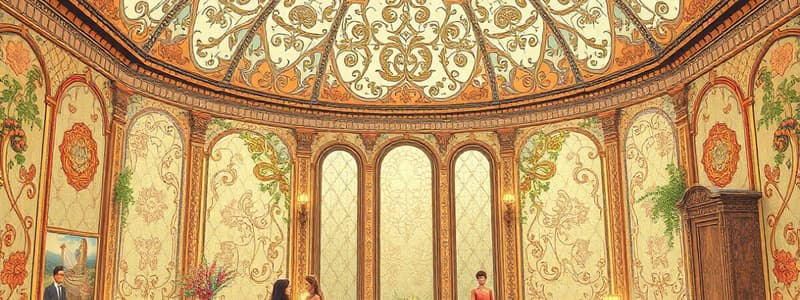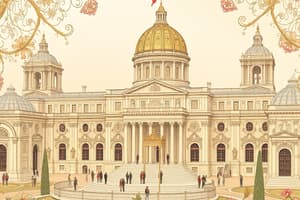Podcast
Questions and Answers
Which type of policy involves multiple organizations collaborating to address common issues like climate change or youth employment?
Which type of policy involves multiple organizations collaborating to address common issues like climate change or youth employment?
- Substantive Policy
- Reactive Policy
- Vertical Policy
- Horizontal Policy (correct)
A local government responds to a sudden outbreak of a new strain of influenza by implementing emergency health measures. What type of policy is this considered?
A local government responds to a sudden outbreak of a new strain of influenza by implementing emergency health measures. What type of policy is this considered?
- Distributive Policy
- Substantive Policy
- Reactive Policy (correct)
- Proactive Policy
During which stage of the policy-making process are potential legislative options developed and analyzed?
During which stage of the policy-making process are potential legislative options developed and analyzed?
- Policy Assessment/Evaluation
- Policy Implementation
- Policy Formulation (correct)
- Agenda Setting
What is the primary focus of administrative policy?
What is the primary focus of administrative policy?
Which type of public policy is characterized by taking taxes from one group and providing those resources to another?
Which type of public policy is characterized by taking taxes from one group and providing those resources to another?
What is the initial step in the United Nations policy-making process?
What is the initial step in the United Nations policy-making process?
In the Philippines, which body is responsible for drafting legislation?
In the Philippines, which body is responsible for drafting legislation?
Which process ensures that laws and executive actions adhere to the Constitution in the Philippines?
Which process ensures that laws and executive actions adhere to the Constitution in the Philippines?
Which elements are LEAST likely to be associated with 'Good Governance', as defined by the United Nations?
Which elements are LEAST likely to be associated with 'Good Governance', as defined by the United Nations?
Which aspect of good governance involves considering the viewpoints of all stakeholders in society when creating policy?
Which aspect of good governance involves considering the viewpoints of all stakeholders in society when creating policy?
What is the role of the Preamble in a constitution?
What is the role of the Preamble in a constitution?
Which article in the Philippine Constitution establishes the fundamental principles of governance, ensuring democracy and social justice?
Which article in the Philippine Constitution establishes the fundamental principles of governance, ensuring democracy and social justice?
According to the Philippine Constitution, what is the minimum age requirement to be eligible for the office of President?
According to the Philippine Constitution, what is the minimum age requirement to be eligible for the office of President?
Which power enables the Philippine President to recognize foreign states and enter into treaties?
Which power enables the Philippine President to recognize foreign states and enter into treaties?
Which action falls under judicial review?
Which action falls under judicial review?
What is the term length for a Senator in the Philippines?
What is the term length for a Senator in the Philippines?
Which of the following responsibilities belongs to the legislative body?
Which of the following responsibilities belongs to the legislative body?
Ensuring individual liberties and protecting against government abuses is the MOST direct purpose of which of the following?
Ensuring individual liberties and protecting against government abuses is the MOST direct purpose of which of the following?
Under the modern concept of good governance, what is often identified as a primary obstacle to development in many countries?
Under the modern concept of good governance, what is often identified as a primary obstacle to development in many countries?
What is the key function of the Supreme Court within many democratic governments?
What is the key function of the Supreme Court within many democratic governments?
Which of the following qualities in leadership best promotes the goals of 'Good Governance'?
Which of the following qualities in leadership best promotes the goals of 'Good Governance'?
In a constitutional monarchy like the United Kingdom, which entity typically holds the ceremonial role as Head of State?
In a constitutional monarchy like the United Kingdom, which entity typically holds the ceremonial role as Head of State?
In Japan's government structure, what role does the Emperor primarily fulfill?
In Japan's government structure, what role does the Emperor primarily fulfill?
Which type of policy-making traditionally occurs within a single organizational structure, starting with broad overarching policies?
Which type of policy-making traditionally occurs within a single organizational structure, starting with broad overarching policies?
After legislation has been drafted in the Philippines, what is the next typical step in the policy making process within the legislature?
After legislation has been drafted in the Philippines, what is the next typical step in the policy making process within the legislature?
What step occurs directly after 'Voting and Adoption' in the United Nations policy-making framework?
What step occurs directly after 'Voting and Adoption' in the United Nations policy-making framework?
According to the materials, what must be recognized for ethics and leadership to result in Good Governance?
According to the materials, what must be recognized for ethics and leadership to result in Good Governance?
What is the ultimate aim of 'transparency' within the context of good governance?
What is the ultimate aim of 'transparency' within the context of good governance?
What is the primary characteristic required of legal frameworks in a system exhibiting 'Good Governance'?
What is the primary characteristic required of legal frameworks in a system exhibiting 'Good Governance'?
Which role does the President of China possess under its constitution?
Which role does the President of China possess under its constitution?
Which concept is described as being designed to limit the actions of persons or groups to protect the general public?
Which concept is described as being designed to limit the actions of persons or groups to protect the general public?
What is the required minimum age to serve as a member of The House of Representatives, in congress, within the Philippines?
What is the required minimum age to serve as a member of The House of Representatives, in congress, within the Philippines?
Which branch of government is typically tasked with policy implementation?
Which branch of government is typically tasked with policy implementation?
What action does the legislative have the power to conduct according to the provided text?
What action does the legislative have the power to conduct according to the provided text?
Which of these concepts refers to decision-making that includes input from all levels of society, not just a few elites or leaders?
Which of these concepts refers to decision-making that includes input from all levels of society, not just a few elites or leaders?
In the Philippines, what specific document lists the fundamental rights that the government must respect?
In the Philippines, what specific document lists the fundamental rights that the government must respect?
What role do committees play in policy-making within the legislative branch of the Philippines?
What role do committees play in policy-making within the legislative branch of the Philippines?
Flashcards
Policy Making
Policy Making
A decision-making framework or course of action to achieve a desired affect or change, especially in politics, economics, or business.
Substantive Policy
Substantive Policy
Concerned with legislation, programs, and practices governing community work, including income security, employment initiatives, and child care services.
Administrative Policy
Administrative Policy
Largely focuses on the processes involved, such as data collection and program evaluation.
Horizontal Policy
Horizontal Policy
Signup and view all the flashcards
Vertical Policy
Vertical Policy
Signup and view all the flashcards
Reactive Policy
Reactive Policy
Signup and view all the flashcards
Proactive Policy
Proactive Policy
Signup and view all the flashcards
Agenda Setting
Agenda Setting
Signup and view all the flashcards
Policy Formulation
Policy Formulation
Signup and view all the flashcards
Policy Adoption/Legitimization
Policy Adoption/Legitimization
Signup and view all the flashcards
Policy Implementation
Policy Implementation
Signup and view all the flashcards
Policy Assessment/Evaluation
Policy Assessment/Evaluation
Signup and view all the flashcards
Public Policy System
Public Policy System
Signup and view all the flashcards
Regulatory Policy
Regulatory Policy
Signup and view all the flashcards
Distributive Policy
Distributive Policy
Signup and view all the flashcards
Redistributive policy
Redistributive policy
Signup and view all the flashcards
Policy Making
Policy Making
Signup and view all the flashcards
Policy Making Process
Policy Making Process
Signup and view all the flashcards
Agenda Setting
Agenda Setting
Signup and view all the flashcards
Research Analysis
Research Analysis
Signup and view all the flashcards
Drafting and Negotiation
Drafting and Negotiation
Signup and view all the flashcards
Consultation and Review
Consultation and Review
Signup and view all the flashcards
Committee Review
Committee Review
Signup and view all the flashcards
Voting and Adoption
Voting and Adoption
Signup and view all the flashcards
Implementation
Implementation
Signup and view all the flashcards
Review and Evaluation
Review and Evaluation
Signup and view all the flashcards
Public Engagement
Public Engagement
Signup and view all the flashcards
Conflict Resolution
Conflict Resolution
Signup and view all the flashcards
Legislative Branch
Legislative Branch
Signup and view all the flashcards
Drafting Legislation
Drafting Legislation
Signup and view all the flashcards
Debate and Amendments
Debate and Amendments
Signup and view all the flashcards
Presidential Approval
Presidential Approval
Signup and view all the flashcards
Publication and Effectivity
Publication and Effectivity
Signup and view all the flashcards
Implementation
Implementation
Signup and view all the flashcards
Oversight and Review
Oversight and Review
Signup and view all the flashcards
Executive Branch
Executive Branch
Signup and view all the flashcards
Ethics
Ethics
Signup and view all the flashcards
Governance
Governance
Signup and view all the flashcards
Good governance
Good governance
Signup and view all the flashcards
Participation
Participation
Signup and view all the flashcards
Study Notes
Policy Making
- Policy involves a framework or action to achieve change
- Policy serves as a foundation for decision-making, particularly in politics, economics, or business
Types of Policies
- Substantive Policy governs community work aspects like income security and employment
- Administrative Policy focuses on procedures such as data collection
- Horizontal Policy is formulated by multiple organizations to address a situation where each can only address one aspect
- Vertical Policy develops within a single organization, starting with a broad overarching policy
- Reactive Policy addresses a concern or crisis
- Proactive Policy is pursued through deliberate choice, promoting economic wealth and well-being
Stages of Policy Process
- Agenda Setting identifies issues needing resolution
- Policy Formulation develops policy options
- Policy Adoption/Legitimization involves decision-making by authorities
- Policy Implementation puts policies into action
- Policy Assessment/Evaluation reviews effectiveness and makes adjustments
Public Policy System
- Public Policy system includes regulatory actions, measures, laws, and funding
- It involves a problem needing address, a player influencing the plan, and the finalized course of action
Types of Public Policies
- Regulatory Policy limits actions to protect the public
- Distributive Policy uses tax revenue for individual or group benefits
- Redistributive Policy shifts resources from one group to another
Policy Making in Different Contexts
- Policy making involves organizations creating, modifying, or implementing rules to achieve set objectives
- Activities occur at all levels of government, private, and non-profit sectors
United Nations Policy Making Process
- Agenda Setting identifies key issues
- Research Analysis is conducted
- Drafting and Negotiation refines policy
- Consultation and Review ensures broad agreement
- Committee and Subsidiary Body Review examines policy
- Voting and Adoption finalizes agreement
- Implementation puts policy in place
- Monitoring and Reporting tracks impact
- Review and Evaluation assesses success
- Public Engagement involves the community
- Conflict Resolution addresses disputes
Philippine Legislative Branch Policy Making
- Congress (House and Senate) follows procedure in constitution and rules
- The process occurs in the House of Representatives and the Senate
- Formulation of measures include drafting, review, debate, conference, voting, approval, publication, implementation, and oversight
Executive Branch Policy Making
- The President/Executive departments develop initiatives and programs
- This includes development, formulation, consultation, review, implementation, monitoring, and coordination with Congress
Judicial Branch
- The judiciary interprets laws and ensures justice
- Adjudication
- Interpretation of Laws & Constitution
- Checks & Balances
- Public Interest Litigation
- Legal Interpretation
- Adherence to Legal Principles
- Resolving Administrative Disputes
- Separation of Powers
Ethics and Governance
- Ethics involves conduct values and decision-making
- Governance manages public affairs
- Good governance prevents corruption and ensures accountability
Modern Good Governance
- Good Governance is a cure-all for developing countries
- Governance guides the socio-economic relationship of a country using political, economic, and administrative spheres
Ethics & Leadership
- A good leaders requires a moral-driven with ethical actions
- Leadership fosters values, embraces diversity, and motivates the community
- Integrity, transparency, credibility, opposition to corruption are essential
Good Governance Characteristics
- Minimizes corruption, includes minorities, and responds to needs
- Transparency ensures rule-following decisions
- Responsiveness addresses stakeholders in a timely fashion
- Consensus Orientation requires mediation
- Inclusiveness should seek well-being for everyone
- Accountability involves governmental, private, and civil society
- The aim is accountability to stakeholders
Principles of Good Governance
- Participation includes everyone and stakeholders
- Rule of Law is a fair legal framework
- Transparency allows accessible decision-making
- Responsiveness creates effective institutions
- Consensus Orients creates social welfare
- Ensuring inclusiveness creates opportunistic groups
- Effectiveness produces results through resource use
- Accountability empowers stakeholders
Constitutional Provisions
- Policy-making is a structured procedure that is essential to effective laws and guidelines
- Good governance hinges on principles of responsibility, transparency, and moral conduct
- Participatory governance fosters development that is both sustainable and equitable
Constitutional Provisions
- Preamble introduces the constitution, its principals and values
- Philippine Preamble promotes sovereignty, democracy, social justice, and a humane society
- "We, the sovereign Filipino people, imploring the aid of Almighty God, in order to build a just and humane society..."
Declaration of Principles and State Policies
- These principles underpin the Philippine state, ensuring democracy and development
- The Philippines is a democratic, republican state
- The country renounces war and aims for peace
Bill of Rights
- A list of individual rights that government must uphold
- These rights include due process, free speech, and freedom of movement
Executive Department
- Headed by the President with Vice President and Cabinet
- Qualifications include being a natural-born citizen, registered voter, able to read/write, at least 40 years old, and a resident for 10+ years
- The President serves a six-year term without reelection
Powers of the President
- They have executive, commander-in-chief, appointment, and budgetary powers
Legislative Department
- Congress includes the Senate (24 members) and House of Representatives (members from districts and party-list system)
- Senators have to be a natural-born citizen, at least 35 years old, and a resident for two years
- Representatives: must be a citizen, at least 25 years old, and a district resident for one year
Legislative Responsibilities
- These powers include enacting laws, national budget approval, war declaration, investigation, and oversights
Judicial Department
- The judicial power is held in the Supreme Court, overseeing the lower courts
- Justices must be natural-born citizens, at least 40 years old, and judges/lawyers for 15 years
- Justices remain until the age of 70 or removal
Judiciary Functions
- These include law interpretation, dispute resolution, and review of legislative/executive actions
Government Systems
- England: Constitutional Monarchy/Parliamentary Democracy
- Kuwait: Constitutional Monarchy with elected legislature
- India: Federal Parliamentary Democracy
- China: One-party Socialist Republic
- Japan: Constitutional Monarchy/Parliamentary Democracy
- Brunei: Absolute Monarchy
- North Korea: Single-party Socialist Republic
- South Korea: Presidential Democracy
Studying That Suits You
Use AI to generate personalized quizzes and flashcards to suit your learning preferences.




